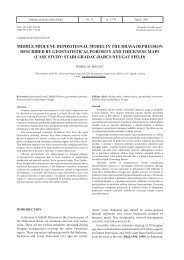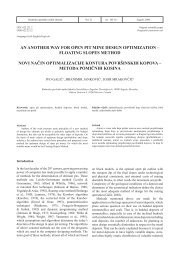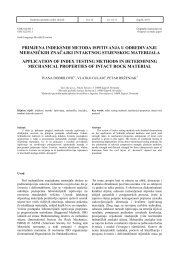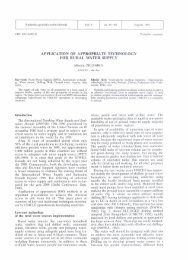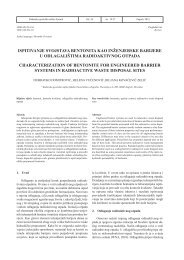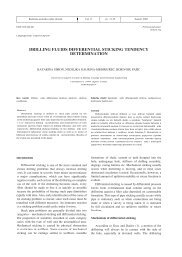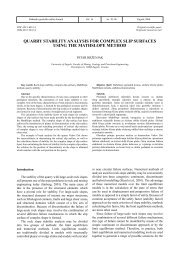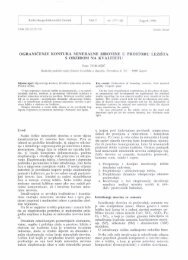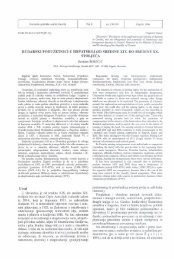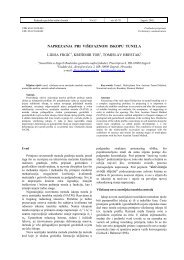continuum and discontinuum modelling in tunnel engineering
continuum and discontinuum modelling in tunnel engineering
continuum and discontinuum modelling in tunnel engineering
Create successful ePaper yourself
Turn your PDF publications into a flip-book with our unique Google optimized e-Paper software.
Rud.-geol.-naft. zb., Vol. 12, Zagreb, 2000.56 Barla, G., Barla M.: Cont<strong>in</strong>uum <strong>and</strong> dis<strong>cont<strong>in</strong>uum</strong> <strong>modell<strong>in</strong>g</strong>%I(a) iFigure 24. YeIded blocks undsheardi.splacements along the jo<strong>in</strong>& aroundthe <strong>tunnel</strong>; (a) determmisfic model, (b) DFN modelplaced on the adoption of dis<strong>cont<strong>in</strong>uum</strong> models whichgive a far more realistic <strong>and</strong> representative picture ofrock mass behaviour than equivalent <strong>cont<strong>in</strong>uum</strong> models.Modell<strong>in</strong>g of rock mass around a 4.75 m diameter<strong>tunnel</strong> excavated by an open TBM configuration throughquartzitic michaschists has been described, with attentionpaid to the <strong>in</strong>stability conditions that developedwhen cross<strong>in</strong>g through a fault zone. The calculationswere performed by us<strong>in</strong>g the f<strong>in</strong>ite element method <strong>and</strong>the dist<strong>in</strong>ct element method, accord<strong>in</strong>g to a two dimensional<strong>modell<strong>in</strong>g</strong> format, three-dimensional representationbe<strong>in</strong>g too limited <strong>and</strong> not justifiable <strong>in</strong> respectof the uncerta<strong>in</strong>ties of the <strong>in</strong>put data.With the f<strong>in</strong>ite element method an equivalent <strong>cont<strong>in</strong>uum</strong>approach was applied, <strong>in</strong>clud<strong>in</strong>g the <strong>in</strong>fluence oftwo major discont<strong>in</strong>uities on the right wall. With thedist<strong>in</strong>ct element method a fully di<strong>cont<strong>in</strong>uum</strong> approachwas used by either a determ<strong>in</strong>istic or discrete featurenetwork model. The dis<strong>cont<strong>in</strong>uum</strong> representation of therock mass captures <strong>in</strong> a remarkable manner the <strong>in</strong>stabilityconditions that developed at the TBM head dur<strong>in</strong>gexcavation. In comparison, the <strong>cont<strong>in</strong>uum</strong> representationgives a more idealised illustration of the <strong>in</strong>stability.It is concluded that for stability analysis peculiargeologic conditions such as fault zones around the <strong>tunnel</strong>require specific models, which reflect the given conditions<strong>in</strong> the most realistic way possible.Received: 2000-05-24Accepted: 2000-09-21Figure 25. Block movemertls around the funnel, (a) determ<strong>in</strong>istic model,(6) DFN d lREFERENCESBarla, G., M. Barla, L. Repetto (1999): Cont<strong>in</strong>uug <strong>and</strong>dis<strong>cont<strong>in</strong>uum</strong> <strong>modell<strong>in</strong>g</strong> for design analysis of <strong>tunnel</strong>s. 9 . Int.Coner. on Rock Mech. Paris. France.B<strong>and</strong> is ,"s . (1993): ~n~<strong>in</strong>eer<strong>in</strong>e properties <strong>and</strong> characterization ofrock discont<strong>in</strong>uities. Com~rehenslve Rock Ene<strong>in</strong>ee~e. Volume1. Fundamentals ~udsoi J.A, editor). pp. 153-183. PergamonPre~s, Oxford (U Ii ).Barton , N ., R . ' ~ e.n i , J . L u n d e (1974): Eng<strong>in</strong>eer<strong>in</strong>g classificationof jo<strong>in</strong>ted rock maqses for the design of <strong>tunnel</strong> supportRock Mechanics. Vol. 6, pp.189-236.Bart on, N. (1997): Pont Ventoux Hydropower Project. TunnelF2-Poet Ventoux. Assessment of geological condilwns <strong>and</strong>suppofifor ch 2350-dWO Report to Nocon. 25 October;%gdBarton, N. (1998): Quantitative description of rock mawes for thedesign of NMT re<strong>in</strong>forcement Spec~al Lecture 1). Int. Conf. onHydro Power Development In h imalayas. Shimla, IndiaBart on, N. 61999): General report concern<strong>in</strong>g some 2Dth centurylessons an 21S'century challenges <strong>in</strong> ap lied rock mechanics. 9thInternational Congress on Rock ~ecianics. August 25 -28.1999, Paris.Brown, E.T., J.W. Bray, B. Ladanyi, E. Hoek 1983):Characteristic l<strong>in</strong>e calculations fur rock <strong>tunnel</strong>s. J. Geotec I, . Eng.Div. Am. Soc. Civ. Enp. 109. pp.15-39.Cundall, P. A., R. D. Hart (1993): Numerical <strong>modell<strong>in</strong>g</strong> ofdiscont<strong>in</strong>ua. Comprehensive Rock Eng<strong>in</strong>eer<strong>in</strong>g. Volume 2.Analysis <strong>and</strong> Design Methods (Hudson J.A., editor). pp. 231-261. Pergamon Press, Oxford (UK).Curran, J. H. <strong>and</strong> Corkun, B. T. (1997): phase2. 2D f<strong>in</strong>iteelcment program for calculat<strong>in</strong>g stresses <strong>and</strong> estimat<strong>in</strong>g su portaround underground excavations. Reference Manual <strong>and</strong> futorialManual. Rock Eng<strong>in</strong>eer<strong>in</strong>g Group. University of Toronto.Dershowitz, W., G. Lcc, J. Geier, P. La Po<strong>in</strong>tc,(1995):FracMan Interactivc Discrcte Feature Data Analysis,



